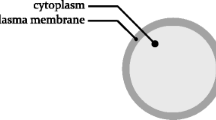Abstract
Impedance microfluidic cytometry is a non-invasive, label-free technology that can characterize the dielectric properties of single particles (beads/cells) at high speed. In this paper we show how digital signal processing methods are applied to the impedance signals for noise removal and signal recovery in an impedance microfluidic cytometry. Two methods are used; correlation to identify typical signals from a particle and for a noisier environment, an adaptive filter is used to remove noise. The benefits of adaptive filtering are demonstrated quantitatively from the correlation coefficient and signal-to-noise ratio. Finally, the adaptive filtering method is compared to the Savitzky–Golay filtering method.








Similar content being viewed by others
References
Ayliffe HE, Frazier AB, Rabbitt RD (1999) Electric impedance spectroscopy using microchannels with integrated metal electrodes. IEEE J MEMS 8:50–57
Barak P (1995) Smoothing and differentiation by an adaptive-degree polynomial filter. Anal Chem 57:2758–2762
Cheung K, Gawad S, Renaud Ph (2005) Impedance spectroscopy flow cytometer: on-chip label-free cell differentiation. Cytometry Part A 65A:124–132
Coulter WH (1956) High speed automatic blood cell counter and cell analyzer. Proc Natl Electron Conf 12:1034–1040
Cho YH, Yamamoto T, Sakai Y, Fujii T, Kim B (2006) Development of microfluidic device for electrical/physical characterization of single cell. J Microeletromech Syst 15:287–295
Fuller CK, Hamilton J, Ackler H, Krulevitch P, Boser B, Eldredge A, Becker F, Yang J, Gascoyne P (2000) Microfabricated multi-frequency particle impedance characterization system. Proc μTAS 2000:265–268
Gawad S, Cheung K, Seger U, Bertsch A, Renaud Ph (2004) Dielectric spectroscopy in a micromachined flow cytometer: theoretical and practical considerations. Lab Chip 4:241–251
Gawad S, Schild L, Renaud Ph (2001) Micromachined impedance spectroscopy flow cytometer for cell analysis and particle sizing. Lab Chip 1:76–82
Gawad S, Sun T, Green NG, Morgan H (2007) Impedance spectroscopy using maximum length sequences (MLSA): application to single cell analysis. Rev Sci Instrum 78:054301
Holmes D, Sandison ME, Green NG, Morgan H (2005) On-chip high-speed sorting of micron-sized particles for high-throughput analysis. IEE Proc Nanobiotechnol 152:129–135
Jang LS, Wang MH (2007) Microfluidic device for cell capture and impedance measurement. Biomed Microdevices 9:737–743
Mittermayr CR, Frischenschlager H, Rosenberg E, Grasserbauer M (1997) Filtering and integration of chromatographic data: a tool to improve calibration? J Anal Chem 358:456–464
Malleo D, Nevill JT, Carlo DD, Lee LP, Morgan H (2007) Examining cytotoxic effects on single cells using an impedance spectroscopy platform. Proc μTAS 2:1083–1085
Morgan H, Holmes D, Green NG (2006) High speed simultaneous single particle impedance and fluorescence analysis on a chip. Curr Appl Phys 6:367–370
Morgan H, Green NG (2003) AC electrokinetics: colloids and nanoparticles. Research Studies Press, Baldock
Morgan H, Sun T, Holmes D, Gawad S, Green NG (2007) Single cell dielectric spectroscopy. J Phys D Appl Phys 40:61–70
Müller S, Massarani P (2001) Transfer-function measurement with sweeps. JAES 443–471
Narasimhan SV, Dutt DN (1996) Application of LMS adaptive predictive filtering for muscle artifact (noise) cancellation from EEG signals. Comput Elect Eng 22:13–30
Pinto L, Dhanantwari A, Wong W, Stegriopoulos S, Maris M (2002) Blood pressure measurement in noise intensive environments using adaptive interference cancellation. Ann Biomed Eng 30:657–670
Papezova S (2003) Signal processing of bioimpedance equipment. Sens Actuators B 95:328–335
Savitzky A, Golay MJE (1964) Smoothing and differentiation of data by simplified least squares procedures. Anal Chem 36:1627–1639
Sakuta K, Mizoguti K, Setoguchi A, Itozaki H (2006) System noise cancellation by digital signal processing for SQUID measurement. Superconductor Sci Technol 19:S407–S410
Sun T, Green NG, Gawad S, Morgan H (2007a) Analytical electric field and sensitivity analysis for two microfluidic impedance cytometer designs. IET Nanobiotechnol 1:69–79
Sun T, Gawad S, Bernabini C, Green NG, Morgan H (2007b) Broad-band single cell impedance spectroscopy using maximum length sequences: theoretical analysis and practical considerations. Meas Sci Tech 18:2859–2868
Sun T, Holmes D, Gawad S, Green NG, Morgan H (2007c) High speed multi-frequency impedance analysis for single particles in a microfluidic cytometer using maximum length sequences. Lab Chip 7:1034–1040
Semmlow JL (2004) Biosignal and biomedical image processing Matlab-based applications. Marcel Dekker, NewYork
Treichler JR (1979) Transient and convergent behavior of the adaptive line enhancer. IEEE Trans Acoust Speech Signal Process ASSP 27:53–62
Thakor NV, Zhu YS (1991) Applications of adaptive filtering to ECG analysis: noise cancellation and arrhythmia detection. IEEE Trans Biomed Eng 38:785–794
Wang YN, Kang Y, Xu D, Chon CH, Barnett L, Kalams SA, Li D, Li D (2008) On-chip counting the number and the percentage of CD4+ T lymphocytes. Lab Chip 8:309–315
Widrow B, Glover JR, McCool JM, Kaunitz J, Willams CS, Hearn RH, Zeidler JR, Dong E, Goodlin RC (1975) Adaptive noise cancelling: principles and applications. Proc IEEE 63:1692–1716
Zeidler JR, Satorius EH, Chabries DM, Wexler HT (1978) Adaptive enhancement of multiple sinusoids in uncorrelated noise. IEEE Trans Acoust Speech Signal Process ASSP 26:240–254
Acknowledgments
This work was partly funded by the University of Southampton, Life Science Initiative (LSI) and Philips. The authors would like to thank Mr. Rong Zhang for valuable discussions.
Author information
Authors and Affiliations
Corresponding author
Rights and permissions
About this article
Cite this article
Sun, T., van Berkel, C., Green, N.G. et al. Digital signal processing methods for impedance microfluidic cytometry. Microfluid Nanofluid 6, 179–187 (2009). https://doi.org/10.1007/s10404-008-0315-3
Received:
Accepted:
Published:
Issue Date:
DOI: https://doi.org/10.1007/s10404-008-0315-3




